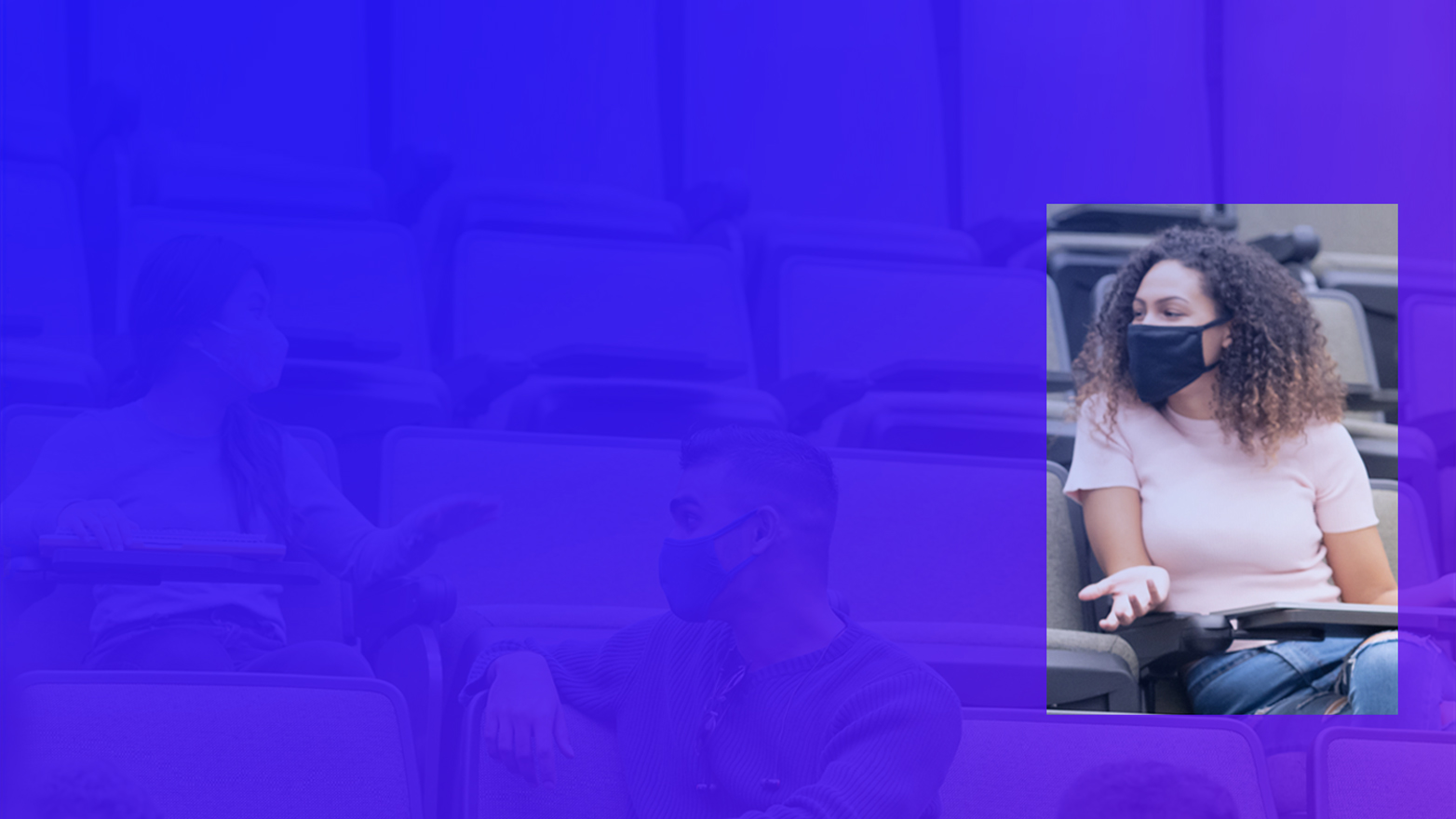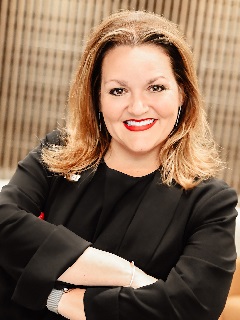Podcast Transcript
Host: College campuses are all about communal living. Students sleep in dorms, eat in cafeterias, and study in halls that hold hundreds. So when the COVID-19 pandemic hit, they faced a huge challenge.
Donna Souder Hodge: Campuses like ours, we had students who didn’t leave because they had nowhere else to live.
Host: Colleges needed a way to keep students safe on campus.
Donna Souder Hodge: And so we made this huge list. We needed a way for students to report more accurately, if they had symptoms. We needed a way to communicate very, very quickly. Because if we were going to come back in the second week of January, we needed to figure out all of those answers.
Host: Turns out technology was key to getting those answers.
Ellen Pelletier: They made an API for us to be able to pull the information back to our app.
Werner Vanzyl: It’s two clicks and they would have their badge to be able to go on campus, if they needed to.
Host: This is Speed to Modern Tech, an original podcast from KPMG. I’m Tori Weldon. Each episode, we'll bring you a problem many businesses are facing and the story of how technology was used to tackle it. Today, helping colleges keep people safe on campus during the COVID-19 pandemic -- and the technology used to track thousands of students’ test results, symptoms and contacts, all in real time.
The date was March 9, 2020. Donna Souder Hodge was on campus at Colorado State University Pueblo, doing what she often does -- attending a campus event.
Donna Souder Hodge: We have about 500 of our employees and a bunch of our students, and we're at the fountain in the middle of our campus and it's a beautiful day in March in Southern Colorado. And we felt very hopeful still. Yes, this COVID thing is still sort of swirling around us and we're paying a lot of attention and taking it seriously, but it didn't mean anything yet. That was Monday. By Friday - Friday the 13th, the entire state of Colorado had shut down. So that is how rapidly our situation changed.
Host: Like many people around the world, Donna's life turned upside down that week. The World Health organization declared COVID-19 a global pandemic. And as the Vice-President of University Operations and Advancement, she went from planning a new student exchange program to shutting down classes in less than a week.
Donna Souder Hodge: That week was frantic because we serve a minority student population. We live in a part of our state, a region of our state that is under-resourced. Our students work full-time jobs while they're attending college full time, juggling families and work, and having to come to real terms with what does remote learning look like for a campus like us? Our students don't have access to computers at home. They don't come to campus with laptops. Realizing that our employees didn't always have computers at home, they weren't set up. No one was doing Zoom. So within literally three days we were ordering every single computer we could get our hands on. We were finding every untouched, discretionary dollar we could put toward this, and we still had no idea what this would look like for our employees or our students.
Host: Like many universities across the United States, the campus became a ghost town. Classes went online, events were canceled, and administration scrambled to figure out how to keep people safe. The university finished the 2020 term online, and spent the summer planning for a return to class in the fall.
Donna Souder Hodge: The plan was always return to normalcy. So we had spent the summer doing things like making a decision - did we move furniture out of rooms if we're reducing capacity by 50%? We're trying to check what our air flow in any given building may be. We had reduced classroom sizes. We had moved those classes, um, into hybrid formats and had moved them to large spaces on campus. We set up tents and had outdoor classes. By September, we had more cases on this campus than we could handle. And by the end of October, in fact, by Halloween, we had quarantined by that point six or seven of our athletic teams, probably as many entire classes had been quarantined and it was not sustainable.
Host: By the beginning of November, most of the classes had gone back online. Students and staff were at home. And more and more people were being hospitalized with COVID-19.
In 2021, things got worse. Up until then, Colorado used the color red to indicate when COVID levels were at their highest. In the spring, they introduced a new color - purple.
Donna Souder Hodge: It suddenly became very, very clear - Spring of 21 - this is not going to just go away. It is unclear what the future is going to look like. We can't afford to stay just shut down forever, but we couldn't continue to operate as though we weren't just dealing with a global pandemic. So what does a small under-resourced campus do in that case? We didn't have - we have a student healthcare center that was staffed by one nurse practitioner, one part-time RN, two medical assistants and students who do some clinical hours rotating through there. That's not enough to work with 500 full-time employees and 4,000 students.
Host: State public health departments were overwhelmed and colleges had to fill the gap. Anita Barkin was one of the people who stepped in to help. She's a Registered Nurse Practitioner, and Co-Chair of the American College Health Association COVID-19 Task Force.
She helped create the health guidelines that were used by hundreds of colleges to manage the pandemic. And after 28 years as the Director of Health Services at Carnegie Mellon University, she understands the unique issues colleges faced in trying to keep students safe on campus.
Anita Barkin: They live together, they work together, they play together. There's a lot of personal interaction. A lot of close, personal contact, and those are the ideal conditions to spread a highly communicable infection.
Donna Souder Hodge: And so this COVID team shifted from this sort of operational, counting chairs in a room, thinking about what capacity of the ballroom might be, to now thinking about - we have to have a plan for testing anyone who comes to campus. And, oh my gosh, we need a way for people to start reporting this to us in a very systematic way.
Host: Creating a way to test and track students and staff required a new level of organization. But after more than a year of managing the ups and downs of the pandemic, the college health professionals Anita works with were burnt out.
Anita Barkin: They were exhausted. It was a seven day a week, 24 hours a day issue that had to be managed and it was draining.
Host: Donna and her team quickly realized that human effort alone would not be enough. They'd been working flat out since March 2020, and COVID was still not under control.
Donna Souder Hodge: We started by imagining what are all the questions that we have that we can't answer for ourselves? What does an actual testing protocol look like? So we made this huge list. We needed a technology solution. We needed a way for students to report more accurately if they had symptoms, we needed a way to communicate very, very quickly. We needed to figure out all of those answers. That was a big challenge.
Host: It was a similar story at almost every university and college. How to track the thousands of students and staff on campus each day and ensure people with COVID stayed home?
Technology was needed to create a solution that would scale. And that's where Ellen Pelletier and Werner Vanzyl stepped in. They both work in the Digital Solutions and Architecture group at KPMG. Together, they headed up the team who had to build the technology to solve for this pandemic problem.
Ellen Pelletier: So what they essentially wanted was a way for students and faculty to check in and say, I am symptom-free, so that they could then display a pass and be able to get on campus or get into their class or their lecture hall or wherever they're going.
Host: Seems simple right? But in reality, there were a lot of factors that needed to be considered. And the clock was ticking. They needed to have an app ready in just six weeks. So Ellen and her team quickly got to work interviewing students about what they wanted.
Ellen Pelletier: And that was definitely a challenge. I mean, it's a population of young users who use technology in their everyday life for literally everything. So they aren't going to want to deal with any extra steps. They don't want to be needing to have any new credentials that they've got to store, and they want it to be as quick and seamless as possible.
Host: And then there was the other user group, professors and campus employees, who were very different from students.
Werner Vanzyl: The employee community was really a challenge in terms of technology access as well as language access. So we had to really think about the interaction of the users as they go through this process and not have separate apps for different types of users.
Host: As a technologist, Werner had a lot of different ways to build this app. He's spent the last thirty years working on everything from mainframe development to machine learning, and was part of the AI team for IBM's Watson project. He has a lot of tools in his toolkit. Initially, he and his team had planned to use low-code to build the app. As Werner explains it, low code basically uses drag and drop to develop an application. It makes for an easy to build, with pixel perfect design. The only problem? Cost was tied to per person use. And with potentially tens of thousands of people using the app, it was going to be too expensive.
Werner Vanzyl: And we decided to pivot to using a technology called a progressive web application, which is really a web-based phone app that runs on the browser in your phone, but it looks like a native app that runs on the phone.
Ellen Pelletier: So iPhone users would log in with Safari, Android log in with Chrome and they load the URL. I believe the university had QR codes to link it and they were posting it up in residence halls and things like that, and the look and feel feels very similar to an app without having to go through the approval processes that are required - Apple in particular, I believe, is a very, very long approval process in order to get an app into the app store.
Host: Werner says the time it takes to go through the app approval process played a big role in their final decision.
Werner Vanzyl: There's really two primary paths that you need to support when you develop a mobile app. You can do Android or you do Apple. So both of those have very specific development environments, development languages that you have to be able to support. And once you've created the app, you actually submit the app to either Google or Apple for review. They do security reviews, they look at the app design, they look at the screens that you have to submit with those to make sure that it conforms to their standards and their security requirements. And only after that process is completed will they publish the app to their app store. That process can take a long time in today's time to get done. And we knew that because of our fluid environment with COVID, that we would need to push out updates potentially on a weekly basis, um, if not on a daily basis, and we could not afford to go through this review process every time there's a change to the app and get approval from these app stores.
Host: After deciding to go with a progressive web application, Werner and his team started building the app in its most basic form.
But since it was web-based, they also needed to be able to figure out the best technology to serve up this application. Information on the app was changing daily and users needed to see the most up-to-date version every time they opened their phone. Werner and his team opted for a cloud-based serverless technology.
Werner Vanzyl: So one of the things that we never knew from an hour to hour basis is how many people would actually check in. So if we had to do this the old way of provisioning a server, we would have to cater for the maximum amount of people that need to check in at one single time. Which might be a massive amount of hardware that we had to purchase just to support that one burst of traffic per day as everybody wants to check in at 8:00 AM in the mornings to go to campus. With serverless function, it's really meant to scale out and scale back in, automatically. And this is really not just a technology advantage, but it's also an extreme cost advantage because you don't have to pay for this huge hardware infrastructure that might for 90% of the day sit idle. You just pay for the time that you actually use.
Host: Just six weeks after their first meetings with university officials, the team launched a basic application. People could do a symptom check each morning, and get a virtual badge allowing them on campus. But changing health guidelines meant new features had to keep being added to the app - sometimes on a daily basis. Ellen remembers coming out of her regular touch base with the university.
Ellen Pelletier: We had changes that came through at the time where the questionnaires were changing, the guidance was changing from the CDC, but then they also were starting to roll out their own testing and they wanted to be able to quickly and easily provide COVID test results to different students. They also had the instance where they wanted to be able to restrict somebody from even being able to check in at all. If they have somebody who keeps going on campus with COVID and not following the guidelines of quarantine and things like that, they wanted to be able to restrict their pass completely. So those were the kinds of changes that were coming in.
Host: These changes were not just nice to haves. They were needed urgently -- to respond to what was happening with the pandemic.
Ellen Pelletier: I don't know if it's necessarily that challenging to make those adjustments, in general, but it's the speed at which you need to be able to do those things that can be challenging for the developers because they need to quickly figure out how to make those adjustments and implement them, and then you need to have your testers making sure that it doesn't adjust any of the existing functionality. So we were very concerned with the tight timeline.
Host: Over the course of a few weeks, a whole raft of features were added to the app --- test results, symptom reporting, even reminders to students when they were due for a COVID test. The wording also had to keep changing, to keep up with health guidance. But all these required updates were just one side of the coin. They also had to find a way to keep students engaged -- to add value so they would keep using the app.
Werner Vanzyl: We added the ability for somebody to go into the app and actually be able to see what location on campus was busy or not. So they could make informed decisions to say, oh, 10:00 AM in the morning the library is empty. I'm going to go sit there and study instead of going to the cafeteria where everybody's having breakfast. And, um, those types of things, I think, was really a driver to getting people to come back and just do their check-ins. You know, from a student community, you don't want it to sound like it's forced. You always want to give them an incentive to come back rather than just forcing them to do that.
Host: For colleges across the United States, technology played a big role in helping them live with COVID. Donna says having tools to test and track made a huge difference to everyone.
Donna Souder Hodge: We required every employee on campus to be tested multiple times a week. And we were contact tracing 100% of our people and giving everyone a response within 24 hours. And it took our transmission rate, our positivity on this campus, we took it from 20% to 1% because we were testing, we were immediately quarantining. We had a very real protocol and we had partners who had the capacity to help us in a way that we simply didn't, and an expertise that was really critical to this too.
Host: Learning to live with COVID is the new reality for many institutions. And Anita says when it comes to health and safety on college campuses, the expectations are high.
Anita Barkin: It's important for universities to get it right, because the health and well being of students, staff and faculty are primary to conducting business on a college campus. We want to be a safe place where people can learn and thrive. And students and parents, our faculty and staff, have to have trust in the institutions that their health and wellbeing is primary.
Host: Looking back on the project today, Werner and Ellen admit it was pretty intense. The project specs kept changing, the technology was new, and their own teams were having to work remotely for the first time. And well, COVID. But it was also what made the work so rewarding.
Ellen Pelletier: So we were very concerned with the tight timeline. We wanted to be able to get it into user's hands quickly
Werner Vanzyl: And we would see on the traffic of that day, that, oh, it was now 30,000 people that checked in instead of just 20. You know, it's not like building a building or a car or something. It's really a very abstract field where you have a vision and a strategy that connects other things to each other. I just love that.
Host: You've been listening to Speed to Modern Tech, an original podcast from KPMG.
Todd Lohr: And I’m Todd Lohr, the head of technology enablement at KPMG.
If you want to know more about the technologies and the people you heard about in this story, go to listen.kpmg.us/TechPodcast or click on the link in the show notes.
Host: And don’t forget to subscribe and leave a review in your favorite podcasting app. We’ll be back with a new episode in two weeks.




